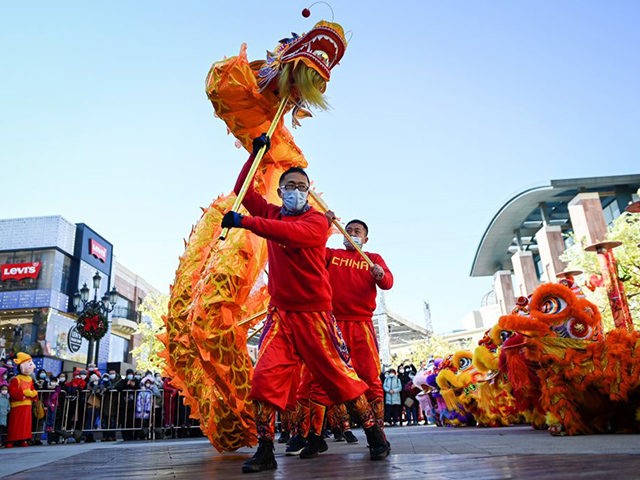China’s Global Times state propaganda newspaper featured on its online front page Tuesday a large gathering of migrant workers in Beijing celebrating the Lunar New Year holiday by making dumplings together.
Despite a recent outbreak of Chinese coronavirus in the capital that triggered strict lockdowns in dozens of communities — and China’s failure to fully eradicate the virus the way its state media outlets have claimed — the feast appeared to feature communal cooking, singing, only occasional sanitary mask-wearing, and other at-risk activities.
The photo report of the event recalled the Chinese Communist Party organizing an attempt at the world’s largest feast, featuring 130,000 people, in Wuhan in January 2020. Wuhan is the source of the Chinese coronavirus and officials there had already documented a raging epidemic situation there when they allowed the banquet to happen.
The Global Times regularly condemns Americans and Westerners in general for allegedly not doing enough to protect from coronavirus infection, blaming individualist and capitalist values.
“The migrant workers who stay in Beijing due to [Chinese coronavirus] control measures celebrated Spring Festival with a community gala in Pi Village, one of the largest urban villages,” the Global Times reported uncritically in an article published on February 11. “They made dumplings, sang songs and read poems with their children to celebrate Chinese [Lunar] New Year.”
Chinese publications refer to the Lunar New Year as “Chinese New Year” despite the fact that many Asian countries and ethnicities observe the holiday.
The photos published by the state outlet show unmasked people in a small room, making dumplings by all grabbing filling from a large bowl with their hands. They do not appear to be wearing gloves, nor are containers of anything that may be hand sanitizer visible. The group also appears to be eating “family-style,” sharing plates.
Public health experts consider communal eating and not wearing masks properly indoors high-risk activities for contracting coronavirus. Personalities like Dr. Anthony Fauci have also condemned singing indoors as a particularly effective method to spread the virus since it requires deeper breathing. Those singing in the photos the Global Times published are not wearing masks and are clearly in close quarters with their audience.
The Lunar New Year feast for migrant workers in Beijing who cannot make it home in time appears to be an annual event, regularly the subject of features in Chinese media.
Similarly, Wuhan, the central Chinese city where the pandemic began, holds an annual Lunar New Year banquet, typically targeted at older members of the community whose children or grandchildren live abroad and cannot make it home for the holiday. Last year, the local Wuhan government allowed the organization of a banquet with 130,000 guests despite the local epidemic raging in the city. The banquet reportedly featured 14,000 dishes, an attempt to break a Guinness World Record, eaten family-style.
The event occurred in January, when Chinese officials were still telling the World Health Organization they did not have evidence that the virus spread from human to human. In reality, leaked Chinese government data published by the South China Morning Post revealed the first confirmed Chinese coronavirus case was documented on November 17, 2019, giving Wuhan officials months to cancel the banquet. Taiwanese officials had also warned the W.H.O. in December that they had reason to believe the disease spreading in Wuhan was contagious and similar to SARS, another type of coronavirus.
The feast in Beijing last week followed a difficult month for the capital, which faced rolling lockdowns in the face of a resurgence of cases that defied dictator Xi Jinping’s declaration of victory against the virus in March 2020. The lockdowns affected 1.7 million people in the capital as well as millions throughout China’s northeast, reaching as far up as Heilongjiang province, one of the most severely affected areas last year. Sporadic outbreaks in the nation’s south, particularly in Hong Kong, also raised questions regarding China’s ability to contain the spread of the virus through depriving citizens of their freedom of movement. Chinese officials insisted that the cases prompting the lockdowns were nearly all “imported” from other countries and have since repeatedly claimed that imported frozen food was a major source of coronavirus infections, a claim not supported by any mainstream public health experts.
China has documented slightly more than 100,000 coronavirus cases and fewer than 5,000 deaths, much smaller numbers than comparable nations. Studies have accused the Communist Party, citing China’s initial reluctance to count “mild” coronavirus cases in its tally, of incorrectly documenting the pandemic’s true toll in the country by millions of cases.

COMMENTS
Please let us know if you're having issues with commenting.